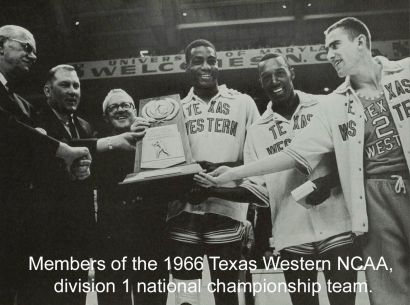This Week's Story
subscribe to podcast [click here] or play audio below
In 1966 Coach Haskins began the 1966 NCAA Division 1 basketball championship game with five black starters.

This Week’s Story relives American history and the Bible through brief inspiring stories presented on mp3 audio recordings and text for reading.
More than Winning! part one
March 19, 1966 basketball sports news was national news! The Miners, a United States team from small Texas Western College, a college of no national fame won the Division 1 NCAA basketball championship!
The biggest shock was that Coach Haskins had begun the game with five black players! Word flashed from radio stations, televisions, phones, and newspapers. How could a coach dare to choose Five Black Starters for a championship game? College basketball in 1966 in the United States was almost completely segregated. Teams in the South never started a game with five blacks. Always there was at least one white starter.
Thousands of letters were sent to Coach Haskins. Texas Western College estimated that 40,000 letters were received. Many were hate-letters. Threats came. The national press was often negative. The team players were accused of being criminals, not really students. Often false information was accepted to be true.
Coach Haskins believed his five black starters were his best players to begin the game. Texas Western was already integrated. The team was integrated, and its guys worked well together.
Coach said later, “To me they were just kids in white-and-orange uniforms. Not white guys, not black guys, just Miners. In later years I coached Hispanics, Native Americans, and foreign players. To me, they were all the same. They were my players. I certainly wasn’t trying to make a social statement. I just wanted to win.”
Within months, and especially within five years after the championship win, schools across the nation were recruiting black players. Many schools were driven by the desire to have competitive teams. More black students were having opportunities to finish college. Coach Haskins’ 1966 national championship team proved they qualified as players and students.
A fair sampling of the players’ future jobs was David Lattin, who was the starting center on the winning team. He became a public relations executive in Houston, Texas. Another sample was Nevil Shed who became a coordinator of student programs for the University Center at University of Texas at San Antonio. All twelve members of the team, white and black, took jobs that required intelligence and commitment.
Coach Haskins had started his life in Enid, Oklahoma in 1930 during the tough years of the Great Depression. Oklahoma was literally the dust bowl of the United States.
Many people left the state to find a job, food to keep from starving, and a better life. Don Haskins’ family were a bit more fortunate. Dad had a steady job driving a truck. Instead of going hungry, the family ate lots of beans and corn. Sometimes there was meat from Dad’s hunting.
In high school Don got a paying job at a feed store. He was paid $1.00 a day. That seemed terrific to him. The Depression was over. World War II was near its end.
Don had a co-worker, Herman Carr, who became his buddy. Both loved to play basketball. Herman was black and Don was white. Herman was the better player according to Don.
This is Barbara Steiner with a story I anticipate continuing.
Enjoy www.thisweeksstory.
<< previous story] [next story >>
We invite your comments! [click here to comment]
This Week's Story is a non-profit supported by listeners. [click here to make a donation]
